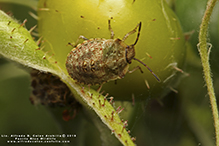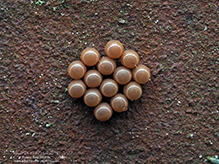stink bugs
(family Pentatomidae)
Overview • Description • Distribution • Taxonomy
Description |
Adults are 3⁄16″ to 11⁄16″ (5 to 18 mm) long, broadly oval, and somewhat shield-shaped. The antennae have five segments, and this is the source of the scientific name of the family. Between the exoskeletal plate covering the thorax (pronotum) and the forewing bases there is a triangular plate (scutellum). The scutellum is very large but it does not reach the tip of the abdomen and it is not longer than the thickened portion of the forewing (corium). The fourth leg segment (tibia) has weak spines or no spines. |
Distribution |
||
|
Sources |
|
| 4/27/2024 | ||
Taxonomy |
|
Order |
Hemiptera (True bugs, Hoppers, Aphids, and Allies) |
Suborder |
Heteroptera (True Bugs) |
Infraorder |
Pentatomomorpha |
Superfamily |
Pentatomoidea (stink bugs, shield bugs, and allies) |
Subordinate Taxa |
|
Subfamily Aphylinae Subfamily Asopinae (predatory stink bugs) Subfamily Cyrtocorinae Subfamily Discocephalinae Subfamily Edessinae Subfamily Pentatominae Subfamily Phyllocephalinae Subfamily Podopinae (turtle bugs) Subfamily Serbaninae Subfamily Stirotarsinae incertae sedis (uncertain placement) |
|
Synonyms |
|
|
|
Common Names |
|
stink bugs |
|
Glossary
Corium
The thickened basal portion of the front wing that lies between the clavus and the membrane of insects in the family Hemiptera. Plural: coria.
Pronotum
The exoskeletal plate on the upper side of the first segment of the thorax of an insect.
Scutellum
The exoskeletal plate covering the rearward (posterior) part of the middle segment of the thorax in some insects. In Coleoptera, Hemiptera, and Homoptera, the dorsal, often triangular plate behind the pronotum and between the bases of the front wings. In Diptera, the exoskeletal plate between the abdomen and the thorax.
Tibia
The fourth segment of an insect leg, after the femur and before the tarsus (foot). The fifth segment of a spider leg or palp. Plural: tibiae.
Visitor Photos |
||
Share your photo of this insect. |
||
This button not working for you? |
||
Alfredo Colon |
||
 |
||
 |
||
MinnesotaSeasons.com Photos |
||
|
||
|
||

Slideshows |
|

Visitor Videos |
||
Share your video of this insect. |
||
This button not working for you? |
||
|
Other Videos |
||
Stink Bugs Pentatomidae |
About
Oct 2, 2013 Damn stink bugs! I am glad I am not the only one that has some. Time for the Pyrethoids! This article told me nothing about how to get rid of them. https://www.pestworld.org/news-hub/guest-columnists/the-truth-about-stink-bugs/ Pentatomidae https://insects.fandom.com/wiki/Stink_Bugs_%E2%80%93_Facts,_Traps,_and_Tips https://www.domyown.com/strube-stink-bug-trap-p-1852.html Synthetic Pyrethroids are particularly effective against these pests because they rapidly effect the insect and paralyze their nervous system.. The most common application method of this compound is spraying it in a liquid from around your home or where you have noticed the insects. |
Pentatomidae in my hand |
About
Jan 30, 2016 Beautiful Cimice in my hand |

Visitor Sightings |
||
Report a sighting of this insect. |
||
This button not working for you? |
||
| Alfredo Colon 6/11/2024 |
Location: Albany, NY |
 |
| Alfredo Colon 8/12/2019 |
Location: Woodbury, Minnesota |
| Alfredo Colon 8/4/2019 |
Location: Woodbury, Minnesota |
MinnesotaSeasons.com Sightings |
||
|

Created: 9/25/2020 Last Updated: © MinnesotaSeasons.com. All rights reserved. |




